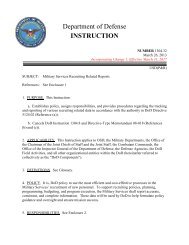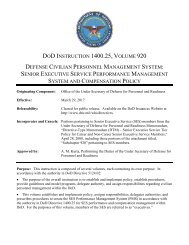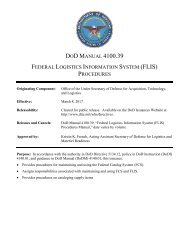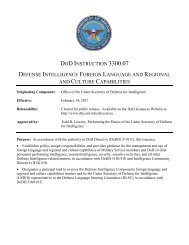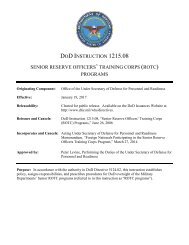520045m
520045m
520045m
Create successful ePaper yourself
Turn your PDF publications into a flip-book with our unique Google optimized e-Paper software.
DoDM 5200.45, April 2, 2013<br />
(g) Vulnerabilities or capabilities of systems, installations, infrastructures, projects,<br />
plans, or protection services relating to the national security (subsection 1.4(g)); or<br />
1.4(h)).<br />
(h) The development, production, or use of weapons of mass destruction (subsection<br />
(4) For classification and declassification of nuclear weapon information (i.e., RD and<br />
FRD), see References (g) and (l).<br />
(5) Pursuant to National Security Decision Directive 189 (Reference (n)), fundamental<br />
research not clearly related to the national security shall, to the maximum extent possible, remain<br />
unrestricted. However, when control is required for national security reasons, classification is<br />
the appropriate mechanism. Refer to Reference (n) and Under Secretary of Defense for<br />
Acquisition, Technology, and Logistics Memorandum (Reference (o)) for additional guidance.<br />
(6) Although information developed by contractors under an independent research and<br />
development (IR&D) effort typically does not qualify for classification, it is possible for<br />
classified information to be generated by IR&D efforts. This may occur when contractors use<br />
properly classified information in their IR&D efforts to explore technological advancements and<br />
state-of-the-art improvements. Information that is generated by or results from an IR&D effort<br />
and is derived from properly classified information requires derivative classification in<br />
accordance with Reference (d). Classification guides developed in accordance with this Manual<br />
can be used by contractors as a source of up-to-date classification guidance for information used<br />
in or generated by their IR&D efforts. Recognition of such use by developers of classification<br />
guides, particularly those addressing leading edge or breakthrough technology, can help to<br />
ensure that information related to national security is consistently protected.<br />
(7) An OCA determines whether specific information should be classified, using the<br />
steps shown in Appendix 1 to this enclosure. These steps may be laid out as a series of<br />
questions, as identified in subparagraphs 2.a.(7)(a) through 2.a.(7)(e). OCAs should review the<br />
following questions throughout the process:<br />
(a) Is the information owned by, produced by or for, or under the control of the U. S.<br />
Government? If the answer to this question is no, the information cannot be classified.<br />
(b) Does the information fall within one or more of the categories of information<br />
identified in sections 1.4(a) through 1.4(h) of Reference (d) or, for nuclear information, meet the<br />
criteria in Reference (g)? If the answer to this question is no, the information cannot be<br />
classified. If the answer is yes, then the next question applies.<br />
(c) Is there a reasonable possibility that the information can be protected from<br />
unauthorized disclosure? If the answer is no, the information cannot be classified. If the answer<br />
is yes, then the next question applies.<br />
10<br />
ENCLOSURE 2



